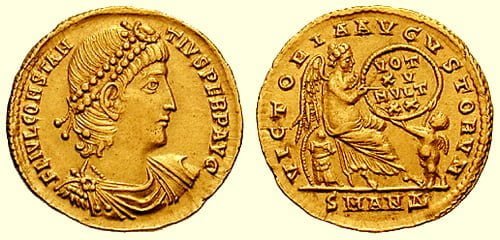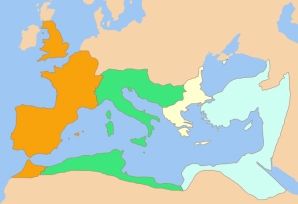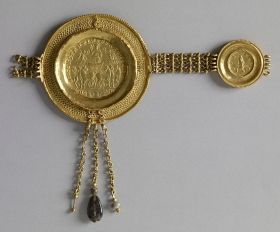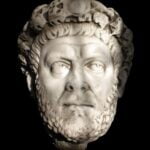Chapters
| Name | Flavius Iulius Constantius |
|---|---|
| Ruled as | |
| Reign | 9 September 337 – 3 November 361 CE |
| Born | 7 August 317 CE |
| Died | 3 November 361 CE |
Constantius II was born on August 7, 317 CE. in Sirminum in Panonia Dolna (Pannonia Inferior) under the names of Flavius Iulius Constantius. He was a Roman emperor in the years 337-361 CE and the son of the ruler of Constantine the Great and his wife Fausta. He ascended the throne with his brothers Constantine II and Constans after his father’s death.
Constantius was born as the third son of Constantine I, and the second to Fausty – the daughter of Emperor Maximian. On November 13, 324, the father appointed the young boy Caesar. In 336 CE War broke out between Rome and Sassanid Persia due to religious unrest and tense relations between Constantine I and Shapur II. Despite the fact that the emperor was making serious preparations for the war, he was forced to stay in the capital due to illness, and he sent his son Constantius to the forefront of the army in Antioch. The young commander was making intensive preparations in the region for the anticipated enemy attack.
August in the East
In early 337 CE, Constantius II had to give up command in the east and hurried to Constantinople, on news of his father’s imminent death. On May 22 died a man rebuilt the Empire and restored some reign after years of civil wars. Constantius bade him farewell in a generous and respectful ceremony at the Church of the Holy Apostles. Soon after his father’s death, Constantius ordered (probably) the massacre of his relatives from his grandfather’s second marriage Constantius I Chlorus. Eutropius, writing between 350 and 370 CE, claims that Constantius approved the order more than he ordered. Two of Constantius’s uncles and six cousins were killed, including Dalmatian and Hannibalianus, the stewards of (successively) Moses and Pontus. The massacres of the deceased ruler’s family were avoided by his two brothers: Constantine II (the elder) and Constans (the younger) and three cousins: Gallus, Julian (later Apostate) and Nepotian.
Shortly thereafter, Constantius II met his brothers in Pannonia in the city of Sirmium to divide the Empire. Eventually, Constantius was given Eastern Provinces, including: Constantinople (which was the capital from his father’s time), Thrace, Asia Minor, Syria, Egypt and Cyrenaica. His brother Constantine II received: Britain, Gaul, Spain and Mauritania; when Konstans had to be content with: Italy, Africa, Illyria, Pannonia, Macedonia and Achaea.
War with Persia
After the disputes over power in the state were resolved, Constantius hurriedly headed east to Antioch to finish the war with the Sassanids, or rather to defend the eastern borders from the attack of Shapur II. In the absence of Constantius, the Persian ruler in early 337 CE he gathered a mighty army of elephants and struck Mesopotamia.
Szapur’s plan was mainly based on an attempt to capture important fortifications, incl. Nisbis, Singara or Amida. Although the Sassanids emerged victorious from most of the situations, these were not important successes. The chief Persian commander was probably Shapur’s brother, Narses, who captured Mesopotamia and captured Amida (with the exception of Nisbis). Constantius immediately attacked Narses’ forces, which were defeated in the Battle of Narasara, and the king’s brother himself fell. Constantius took Amida and began a major process of refortification and fortification of the fortress. In addition, a new fortress was built on his behalf, Antinopolis. Eventually, Constantius managed to contain the Sassanid threat and pushed the enemy forces out of his own territory. In September 350 CE Constantius II ended the war with Persia, thanks to which he was finally able to deal with the affairs of the state.
Meanwhile, Constantius II wished to take control of the land once owned by his brother Konstans. Konstans in 340 CE Constantine II, who was killed in an ambush near Aquileia, took over. In this way, he became the only emperor of the West, and in practice 2/3 of the territory of the Empire. This state of affairs continued until 350 CE when Constans was murdered by forces loyal to the usurper Magnentius.
War with Magnentius
Constantius II, as the only surviving son of Constantine the Great, considered himself the sole and rightful ruler of the entire Empire. He decided to retake the western lands and unite Rome. He decided to march west, led by 40,000 men, to defeat the usurper Magnentius. However, bearing in mind the good of the East, he decided to appoint Constantius Gallus as the Caesar of the East, so as to ensure the stability of the government. To make sure that his cousin did not decide to go against him, he married his scary sister, Constantine, for him.
Before proceeding with the trial with Magnentius, Constantius made an agreement with Vetranio, magistrem militum and the commander of the Danube army under Konstans in Illirium, who had previously been proclaimed emperor by his subordinate troops. Immediately after this situation, he sent a letter to Constantius, in which he guaranteed his loyalty to the ruler. The meeting of Wetranion and Constantius took place on December 25, 350 CE. in the town of Naissus in Serbia. In the presence of the army, Constantius II was recognized as the only legitimate emperor. Constantius, moreover, spared Wetranion’s life and allowed him to live, giving him a high salary for 6 years, until his death, in Bithynia.
On September 28, 351 CE, Constantius II clashed with Magnentius in Pannonia in the Battle of Mursa (today’s Osijek, Croatia), which went down in Roman history as one of the bloodiest and the greatest battles between Roman armies. The balance of power spoke decisively in favour of Constantius (85,000 men), who had 35,000 soldiers against himself.
Constantius’s troops lined up with their backs to the Danube, riding on the wings and archers to the rear. In the afternoon there was an attack of the imperial cavalry, which smashed the light cavalry of Magnentius and came out to its rear. Most of the usurper’s troops were pushed towards the Drava River. His encircled troops were unable to put up much resistance. The battle that lasted until the night ended with the total defeat of Magnentius’ troops. He himself managed to escape beyond the Alps, but the losses on both sides were enormous. Constantius was to lose 30,000 men, 24,000 men were killed on the side of Magnentius. The sight of thousands of dead bodies moved the emperor, who wept over the fate of the soldiers. Soon he ordered the burial of the fallen and the care of the wounded. The battle stopped hostilities for several months.
Magnentius fled to northern Italy, and Constantius decided not to pursue the enemy, but to focus on strengthening the border on the Danube and expeditions against the Sarmatians in early 352 CE. After the situation in Pannonia had stabilized, Constantius went to Italy, where successive cities passed over to his side. Again, Magnentius fled and went to southern Gaul, wherein the Battle of the Jizera River Valley in the summer of 353 CE the remnants of Magnentius’ defeated and retreated to Lugdunum (now Lyon). Left to his fate, the usurper was imprisoned by his own soldiers, who intended to hand him over to Constantius. On August 10, 353 CE. The usurper took his own life and his head was driven around the country as a warning. A similar fate befell the brother of the usurper, Decentius, who a few days later hanged himself in the town of Sens in Champagne. The two-year civil war (also known as the usurpation of Magnentius ) is over. As a result, tens of thousands of the most valuable soldiers of the Empire died. This situation was later taken advantage of by the barbarian tribes, making invasions in Pannonia, Gaul and the Balkans.
Single Ruler
The rest of 353 and the beginning of 354 CE Constantius spent campaigning against the Alamans on the Danube to silence the region. Meanwhile, the Emperor was receiving disturbing reports of his cousin Gallus’s misconduct. Probably in connection with these reports, Constantius made peace with the Alamans and went to Milan. The emperor first called Ursycyn, the military commander of Gallus, for reasons unknown. Then he summoned Gallus and his wife Constantine, who quickly died in Bithynia. Gallus, despite his initial hesitations, travelled to Pannonia, the city of Poetovio (present-day Ptuj), where he was then arrested by Constantius’s soldiers, under the command of Barbation. He was then transferred to the city of Pula, where he was questioned. According to Gallus, the emperor’s sister, Constantine, was responsible for any maladministration and mischief. This enraged Constantius so much that he ordered Gallus to be killed. In a short time, however, he decided to cancel the order, which was ultimately not delivered on time by the eunuch Eusebius. Gallus was killed despite the ruler’s change of mind.
Unexpectedly on August 11, 355 CE magister militum Claudius Silwanusrebelled in Gaul against the Emperor. After the battle of Mursa, Silvanus was awarded the title of commander of troops on the border with Germania and the task of guarding the Germanic border. He achieved his goal mainly due to bribery and a large amount of accumulated money. Information about Silvanus’ disposing of the country’s wealth angered Constantius, who decided to recall Silvanus and summon him to Milan. Ultimately, Ursycyn, who was to replace Silwanus, bribed his soldiers, who then killed the rebel.
Constantius, aware of a large number of threats that the Empire had to face, decided to appoint on November 6, 355 CE. against Caesar Julian, the only surviving member of the family. A few days later, Julian married Helena, the last sister of Constantius, and then went to Gaul.
The next few years Constantius spent overseeing affairs in the western part of the Empire, mainly in Milan. In 357 CE he visited Rome for the first and last time. In the same year, he expelled the Sarmatians and Quadi from Pannonia and Lower Moesia. Then he made a successful counterattack on enemy lands.
In the winter of 357-358 CE In the year Constantius received the emissaries of Shapur II, who demanded the eastern lands lost after the emperor’s counterattack. The Roman ruler wanted to prevent a war and sent two diplomats to the Persian king for this purpose. However, against the requests of the Romans, Shapur launched another campaign in the east. In 360 CE his troops destroyed Singara, Kiphasa, Amida and Ad Tigirs, which forced Constantius to go east.
During this time, Julian led numerous military campaigns against the Alamans invading Gaul. However, when the emperor asked for the Gallic legions to be sent to the eastern front, Julian’s army revolted and proclaimed Julian as emperor.
Due to the serious threat posed by the Persians, Constantius could not deal with another usurper by force. It could only consist of sending emissaries to give up their title and remain Caesar.
The fierce fighting in the east caused heavy losses on both sides. Ultimately, despite the lack of success in regaining the lost fortresses, the Romans stabilized the region, and the Persians themselves did not have the strength to attack again. There was an ideal opportunity to deal with a cousin who was claiming the rights to the imperial crown. Gathering up his strength, he headed west, already seriously ill.
Death
After reaching the city of Mopsuestia (near the Little Asian city of Tarsus) in Cilicia with his troops, Constantius realized that he was terminally ill and would not fight his rival. Constantius, knowing that death was imminent, decided to baptize (he was baptized by the Semiarian Bishop of Antioch, Eusoius) and to appoint Julian as his rightful heir. Constantius died of fever (Ammianus Marcellinus says that it was supposed to take place after three days of illness, probably fever) on November 3, 361 CE. He appointed Julian as his successor in his will.
It is difficult to unequivocally assess the figure of Constantius II, due to the hostility of most sources towards him. In terms of the military, it seems that he showed the characteristics of an ideal commander who was able to mitigate threats and reasonably manoeuvre the troops. As for the mental sphere, Ammianus Marcellinus points out that he was conscientious but vain and stupid. In addition, he was supposed to be shy and suspicious, which often led, as we know, too many murders. In his struggle for power, Constantius managed to kill many members of his family.
Arianism
As emperor, he was a spokesman for Arianism, which he embodied by force through the synods of Arles (353 CE), Milan (355 CE) and Béziers (356 CE). Under his pressure – e.g. in Milan he entered the assembly of bishops with a drawn sword – they were condemned and sentenced to the exile of Athanasius the Great, Hilary of Poitiers, Dionysius of Milan, Pope Liberius and Hosius of Cordoba.
Marriages and Children |
|











